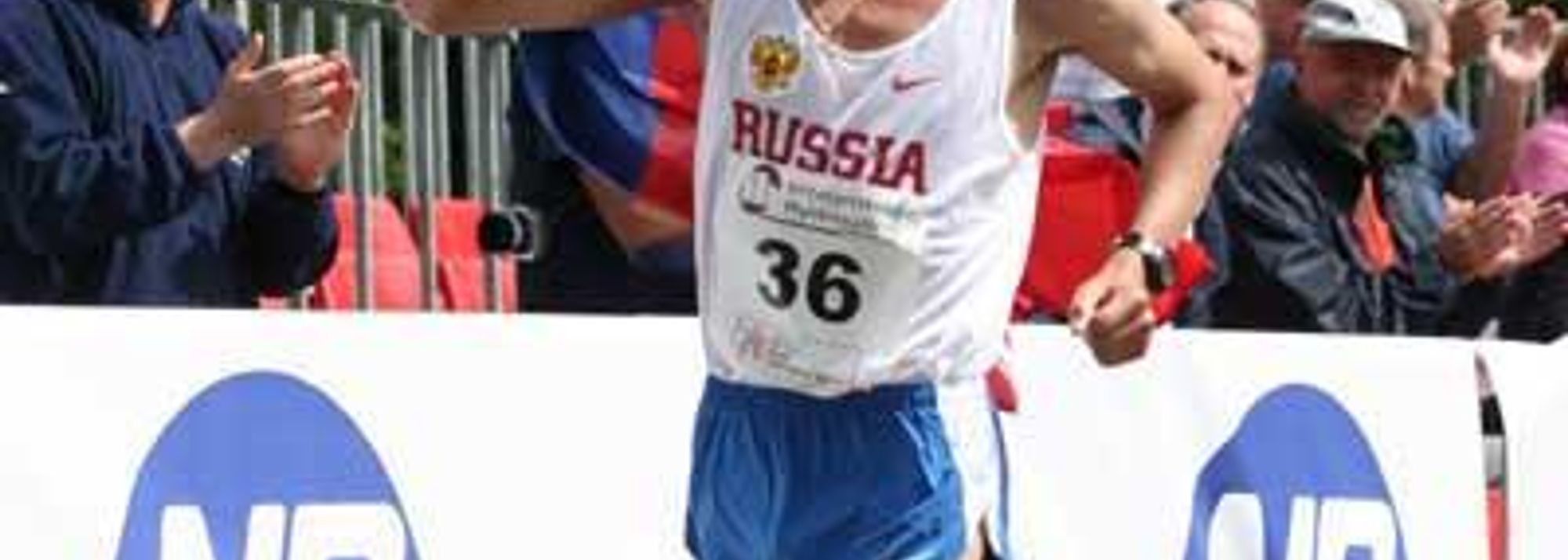Vladimir Kanaykin wins the 2007 European Cup of Race Walking (© Tim Watt)
To go forward you sometimes have to go back as Vladimir Kanaykin discovered.
In this case it was literally the back of the Russian race walker that needed attention – that, and his pelvis. Arguably, not since Elvis’ gyrations stunned the 1950’s rock and pop world has the movement of a pelvis played such a dramatic turnaround in someone’s success.
Kanaykin claimed his first major triumph as a senior at the European Cup of Race Walking last month in Leamington Spa when he took the lead for the first time at 46k, and came home on a difficult circuit just 17 seconds outside his best of 3:40:40.
It’s been a while coming.
The native of Mordovia looked set to be a shoo-in for a trail of honours after he nipped ahead to win the IAAF World Junior Championships 10,000m Race Walk in 2002 by just three seconds as an emerging 18-year-old.
Silver wasn’t the worst result he might have expected in another last-lap burn-up two years later in Italy when less than half-a-second separated him from Russian teammate Andrey Ruzavin.
No doubt he thought he had learned from his rush of blood to the head when he tore up the streets in the junior race at the 2004 World Cup of Race Walking in Naumburg just a couple of months earlier.
Kanaykin was at least 50 metres clear by half-way reached in 19:40 – but that was as far as he got. The judges took exception to his somewhat bouncy style and removed him from the race shortly after while still in the lead.
Undaunted, he charged into the lead of the 50km at the 2005 European Cup in Miskolc, Hungary, but a second 10k split of 43:38 was described as ‘suicidal’ by a master of the sport, Robert Korzeniowski.
The four-time Olympic champion knew the rash split would demand its toll, and there was a lot of knowing looks around the course when Kanaykin was caught at 30km and called it a day.
In his World Cup senior debut at 50km in La Coruna last year, Kanaykin thought he would play a canny waiting game instead, and slowly moved up from 14th to third by 30km. He fared no better after the same red disc that had done for him two years earlier in the junior 10km event was waved in his face a second time.
In light of those disappointments it was something of a comeback to finish 9th in the European Championships in Gothenburg 10 months ago. But although there are plenty who would be grateful for a finishing time of 3:51:51 – you aren’t going to win any medals with that mark.
Cue Korzeniowski the advisor.
The Pole noticed something about Kanaykin’s style he thought he could improve.
“Vladimir was leaning too far forward,” said Korzeniowski. “You need a forward momentum, but his was too exaggerated and he needed to straighten his back.
“He also needed to look at the correct position of his pelvis, and produce a more economic style. I think you can see he has improved.”
Trond Nymark noticed it too – but not for long.
The Norwegian led for 25km at Leamington, and then felt the slight rush of wind that was Kanaykin sprinting past with 4km to go. Nymark said: “I was confident I could hold off the others, but I knew Vladimir’s speed was too good.”
And it appears the Russian has finally come of age outside his own country. As a result, he should be a good bet for a medal at the World Championships in Osaka.
He said: “I have worked on my technique – although there is still more work to be done. I think I’ve also learned that in a race like this (50km) it doesn’t start until 40k. It’s like serving an apprenticeship you can only graduate after you’ve made one or two mistakes along the way.”
Paul Warburton for the IAAF



